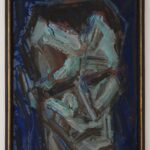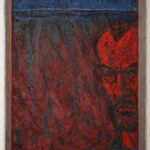
Antanavičius Valentinas
Valentinas Antanavičius – arguably the most consistent nonconformist of his generation. He began actively creating art in the mid-1960s, and up until perestroika remained on the margins of official Soviet art life. During the Soviet era, his works shown in major group exhibitions were almost exclusively portraits. The most important part of Antanavičius’ artistic output—his compositions rich with critical political and social metaphors and distinct iconography—rarely appeared in exhibitions during that period. It wasn’t until 1986, on the occasion of his fiftieth birthday, that he was able to showcase these works in a solo exhibition held in the most prestigious exhibition space in Vilnius—the Palace of Art Exhibitions. After the restoration of Lithuanian independence, his nonconformist contribution to Lithuanian art was recognized with the National Prize for Culture and Arts.
Antanavičius’ work draws on elements of expressionism, surrealism, dadaism, pop art, and Lithuanian folk art. Early in his career, he became familiar with assemblages by neighboring Polish artists such as Tadeusz Kantor, Władysław Hasior, and theater and stage director Józef Szajna. This influential trio inspired him with their theatrical use of found objects—props imbued with symbolic meaning. While Kantor’s “degraded reality” revolved around society’s garbage and poor-quality everyday items, Antanavičius’ assemblages feel less austere, and closer in spirit to Hasior’s rich and colorful accumulations of found materials. Influenced by these artists, Antanavičius ultimately developed a distinctive personal style, rooted in original iconography informed by both personal experience and Lithuania’s modern history.
A significant part of his work consists of allegorical figurative compositions—painted on canvas or cardboard, or assembled from found objects. The main theme in his painting is the threatening, deforming force of totalitarianism. In a symbolic setting resembling an empty stage or backdrop painted with a minimal natural or urban landscape, all attention is directed toward distorted human figures or groups of figures.
A key leitmotif in these paintings is the wounded, bloody, or burned human body. In some compositions, the human figure is transformed into that of a bird or beast, or becomes part of monumental sculptural fragments. These works are marked by both vivid color contrasts and dark tones with expressive brushwork. A closely related group of works are assemblages, in which the theme of totalitarianism is addressed with a more sarcastic than dramatic tone. In them, Antanavičius focuses on the visual metaphor of power symbols intertwined with everyday household debris. To create political and social allegories, he uses a variety of found objects—mostly worn, damaged, or broken-down items, mechanisms, and toys. These are arranged into figurative or anthropomorphic compositions, sometimes accompanied by painted fragments.
Another large category of his assemblages includes compositions featuring ethnographic objects: fragments of household items, textiles, palm bouquets, and Užgavėnės (Mardi Gras) masks. In these works, the “eloquence” of the found object itself takes center stage—though rarely left untouched, as they are usually assembled into archetypal figurative compositions.
After 1990, no radical break occurred in his artistic practice, but the range of subjects expanded. Alongside political and social metaphors, he began creating Christian and literary-themed compositions. In addition to painting and assemblages, Antanavičius has also produced graphic works and stage designs.
Born: 1936
Studies: 1956–1962 – Vilnius State Art Institute
Member of the Lithuanian Artists’ Union
Lecturer at Vilnius Academy of Arts
Lives and works in Vilnius
Exhibiting since: 1966 in Lithuania, France, Denmark, Germany, Hungary, Sweden, United Kingdom, Poland, and more.
1992 – Awarded the National Prize for Culture and Arts
Collections include:
-
Lithuanian Art Museum, Vilnius
-
M. K. Čiurlionis Art Museum, Kaunas
-
Marienburg Castle Museum, Poland
-
Zimmerli Art Museum at Rutgers University, USA
-
Private collectors in Lithuania and abroad
SOLO EXHIBITIONS:
(Only key examples listed for brevity—ask if you’d like the full list again in this format.)
-
1966 – National Library, Vilnius
-
1986, 1989 – Palace of Art Exhibitions, Vilnius
-
1992 – Contemporary Art Centre, Vilnius
-
2006 – “Life Without a Parade”, Retrospective, Radvila Palace, Vilnius
-
2005 – Århus Kunstbygning Gallery, Denmark
SELECTED GROUP EXHIBITIONS:
(Full list available on request.)
-
1962–1988 – Participated in national portrait, watercolor, and ex-libris exhibitions across Lithuania and Eastern Europe
-
1980 – Contemporary Lithuanian Art, Museumspavillon im Mirabellgarten, Salzburg, Austria
-
1989 – Contemporary Soviet Painting, Munich City Hall, Germany
-
1990–1996 – Group “24” exhibitions in Vilnius, Kaunas, Paris, Stockholm, Riga
-
2002 – “ART OF THE BALTICS”, Zimmerli Art Museum, USA
-
2007 – “Experiment”, Radvila Palace, Vilnius



